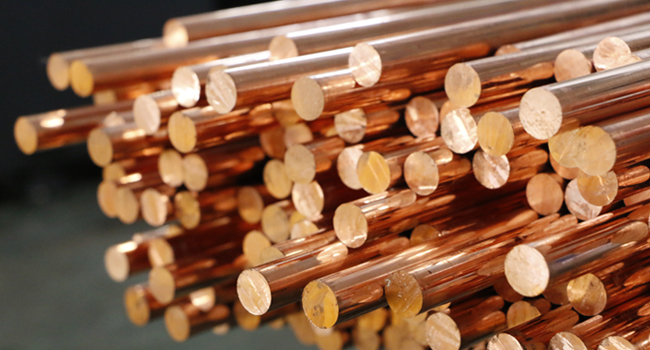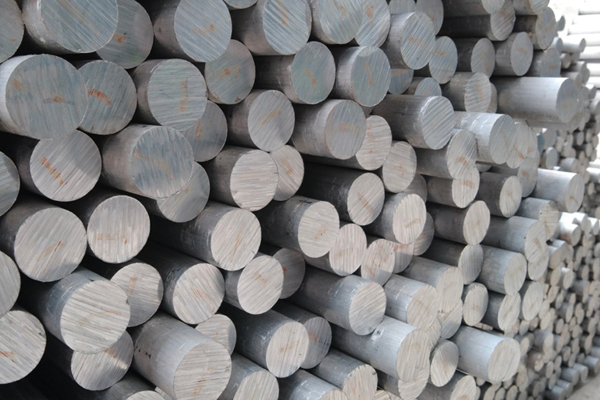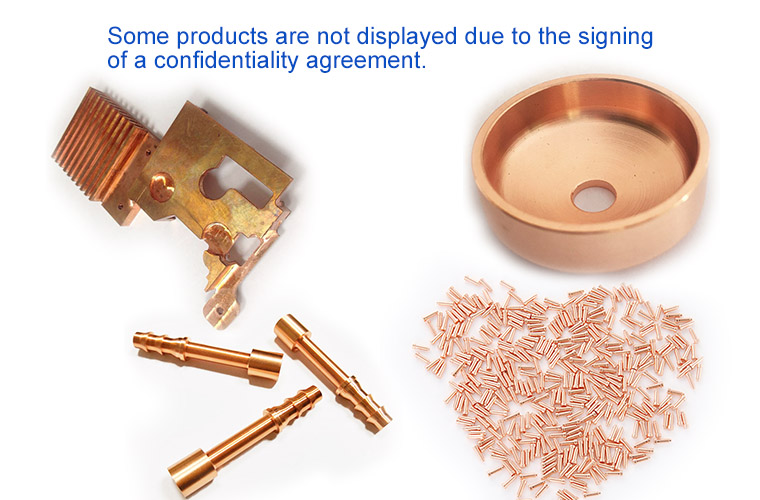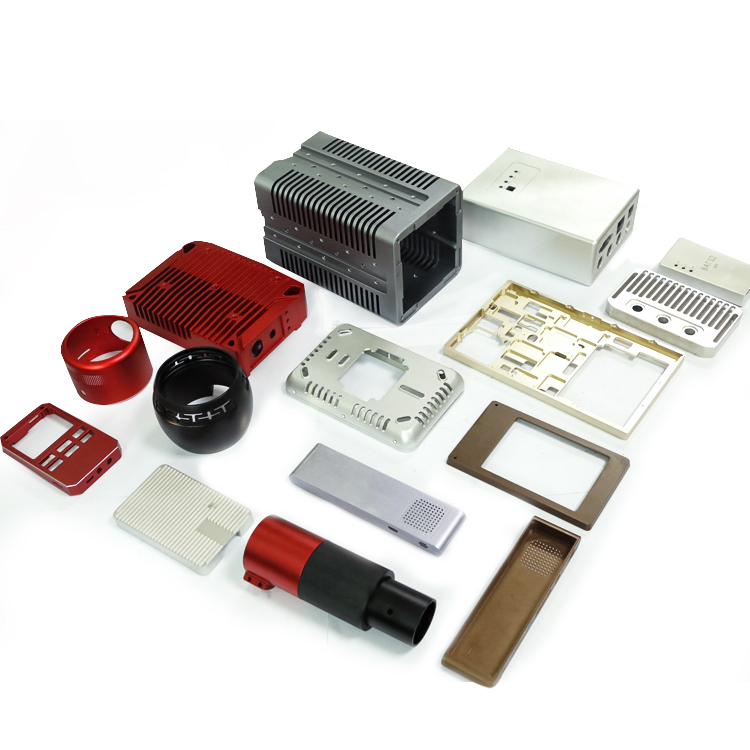Differences Between Copper and Aluminum Metal Materials
Copper and aluminum are two distinct metal materials with varying characteristics and applications. This article outlines the key differences between copper and aluminum in terms of properties, uses, and advantages in different industries.
What is Copper?
Copper is a versatile and widely used metal known for its excellent thermal and electrical conductivity, corrosion resistance, and aesthetic appeal.

Properties and Characteristics of Copper
Copper boasts exceptional thermal and electrical conductivity, making it crucial in electrical wiring and transmission. It’s also malleable and ductile, allowing it to be easily shaped and formed. Its corrosion resistance contributes to its use in plumbing and outdoor applications. Additionally, copper’s reddish-brown color ages gracefully, enhancing its visual appeal.
Common Copper Alloys and Grades
Copper Alloys: Various copper alloys are used to enhance specific properties. Examples include bronze (copper and tin) and brass (copper and zinc).
Grades: Common copper grades include C10100 (Oxygen-Free Electronic), C11000 (Electrolytic Tough Pitch), and C12200 (Phosphorus-Deoxidized, DHP). Each grade offers unique characteristics suited for different applications.
Bronze medal number and standard comparison table of various countries
| China | Germany | Europe | National standard | USA | Japan | ||
| GB | DIN | EN | ISO | UNS | JIS | ||
| TU2 | OF-Cu | 2.0040 | Cu-OFE | CW009A | Cu-OF | C10100 | C1011 |
| – | SE-Cu | 2.0070 | Cu-HCP | CWO21A | – | C10300 | – |
| – | SE-Cu | 2.0070 | Cu-PHC | CW020A | – | C10300 | – |
| T2 | E-Cu58 | 2.0065 | Cu-ETP | CW004A | Cu-ETP | C11000 | C1100 |
| TP2 | SF-Cu | 2.0090 | Cu-DHP | CW024A | Cu-DHP | C12200 | C1220 |
| – | SF-Cu | 2.0090 | Cu-DHP | CW024A | Cu-DHP | C12200 | C1220 |
| – | SF-Cu | 2.0090 | Cu-DHP | CW024A | Cu-DLP | C12200 | C1220 |
| TP1 | SW-Cu | 2.0076 | Cu-DLP | CW023A | Cu-DLP | C12000 | C1201 |
| H96 | CuZn5 | 2.0220 | CuZn5 | CE500L | CuZn5 | C21000 | C2100 |
| H90 | CuZn10 | 2.0230 | CuZn10 | CW501L | CuZn10 | C22000 | C2200 |
| H85 | CuZn15 | 2.0240 | CuZn15 | CW502L | CuZnl5 | C23000 | C2300 |
| H80 | CuZn20 | 2.0250 | CuZn20 | CW503L | CuZn20 | C24000 | C2400 |
| H70 | CuZn30 | 2.0265 | CuZn30 | CW505L | CuZn30 | C26000 | C2600 |
| H68 | CuZn33 | 2.0280 | CuZn33 | CW506L | CuZn35 | C26800 | C2680 |
| H65 | CuZn36 | 2.0335 | CuZn36 | CW507L | CuZn35 | C27000 | C2700 |
| H63 | CuZn37 | 2.0321 | CuZn37 | CW508L | CuZn37 | C27200 | C2720 |
| HPb63-3 | CuZn36Pb1.5 | 2.0331 | CuZn35Pb1 | CW600N | CuZn35Pb1 | C34000 | C3501 |
| HPb63-3 | CuZn36Pb1.5 | 2.0331 | CuZn35Pb2 | CW60IN | CuZn34Pb2 | C34200 | – |
Advantages of Copper
High Conductivity: Copper’s exceptional electrical conductivity is vital for electrical wiring and transmission.
Corrosion Resistance: Copper’s natural oxide layer provides inherent corrosion resistance, making it suitable for plumbing and outdoor applications.
Aesthetic Appeal: Copper’s distinct reddish-brown hue and patina over time contribute to its visual appeal in architectural and artistic applications.
Recyclability: Copper is highly recyclable, reducing environmental impact and promoting sustainability.
Disadvantages of Copper
Cost: Copper can be more expensive compared to other metals, impacting its use in budget-sensitive projects.
Weight: Copper’s density can make it heavier than alternative materials, affecting its suitability for lightweight applications.
Staining: Copper’s natural patina can stain surrounding materials, requiring maintenance in certain applications.
Choosing the Right Copper Grade
Consider your project’s requirements, including conductivity, corrosion resistance, and appearance.
Choose oxygen-free copper (C10100) for high-purity electrical applications.
Opt for brass or bronze alloys for applications requiring enhanced strength or specific aesthetics.
Conclusion
Copper’s versatility, conductivity, and corrosion resistance have made it a staple in numerous industries. By understanding its alloys, properties, and potential drawbacks, you can confidently select the appropriate copper grade for your projects. Whether you’re constructing electrical systems, architectural elements, or artistic pieces, copper’s enduring qualities contribute to the success and longevity of your creations.
What is Aluminum?
Aluminum is a lightweight and versatile metal known for its corrosion resistance, electrical conductivity, and wide range of applications.

Properties and Characteristics of Aluminum
Aluminum is prized for its lightweight nature, making it ideal for applications requiring reduced weight without sacrificing strength. It boasts excellent corrosion resistance due to its natural oxide layer, which protects it from environmental factors. Aluminum also possesses good electrical conductivity and is highly recyclable.
Common Aluminum Alloys and Grades
Aluminum Alloys: Aluminum is alloyed with other elements like copper, magnesium, and silicon to enhance specific properties.
Grades: Common aluminum grades include 6061, 5052, and 7075. Each grade offers distinct characteristics suited for various applications.
Aluminum medal number and standard comparison table of various countries
| China | National standard | USA | Japan | Former Soviet Union | Germany | UK | France |
| GB | – | AA | JIS | OCT | DIN | BS | NF |
| LG5 | OF-Cu | 1199 | 1N99 | AB000 | A199.98R | S1 | – |
| LG2 | – | 1090 | 1N90 | AB1 | A199.9 | – | – |
| LG1 | A199.8 | 1080 | A1080 | AB2 | A199.8 | 1A | – |
| L1 | A199.7 | 1070 | A1070 | A00 | A199.7 | – | 1070A |
| L2 | – | 1060 | A1060 | AO | – | – | – |
| L3 | A199.5 | 1050 | – | A1 | A199.5 | 1B | 1050A |
| L5-1 | A199.0 | 1100 | A1100 | A2 | A199.0 | 3L54 | 1100 |
| L5 | – | 1200 | A1200 | – | A199 | 1C | 1200 |
| LF2 | AlMg2.5 | 5052 | A5052 | AMr | AlMg2.5 | N4 | 5052 |
| LF3 | AlMg3 | 5154 | A5154 | AMr3 | AlMg3 | N5 | – |
| LF4 | AlMg4.5Mn0.7 | 5038 | A5038 | AMr4 | AlMg4. 5Mn | N8 | 5083 |
| LF5-1 | AlMg5 | 5056 | A5056 | – | AlMg5 | N6 | – |
| LF5 | AlMg5Mn0.4 | 5456 | – | Amr5 | – | N61 | – |
Advantages of Aluminum
Lightweight: Aluminum’s low density makes it suitable for industries where weight reduction is critical, such as aerospace and automotive.
Corrosion Resistance: Aluminum’s oxide layer provides inherent corrosion resistance, making it applicable for outdoor and marine environments.
Electrical Conductivity: While not as conductive as copper, aluminum’s conductivity is adequate for many electrical applications.
Recyclability: Aluminum is highly recyclable, contributing to sustainability and reducing environmental impact.
Disadvantages of Aluminum
Softness: Aluminum’s lower hardness compared to some other metals can impact its durability in certain applications.
Lower Strength: While some aluminum alloys offer high strength, they might not match the strength of steel or other materials.
Potential Galvanic Corrosion: When in contact with certain metals, aluminum can undergo galvanic corrosion.
Choosing the Right Aluminum Grade
Consider your project’s requirements, including strength, corrosion resistance, and conductivity.
Choose 6061 for versatility, corrosion resistance, and machinability.
Opt for 7075 for applications requiring high strength and durability, such as aerospace components.
Conclusion
Aluminum’s unique combination of properties makes it an indispensable material in various industries. By understanding its alloys, characteristics, and potential drawbacks, you can confidently select the appropriate aluminum grade for your projects. Whether you’re designing structures, electronics, or consumer products, aluminum’s advantages contribute to the functionality and success of your creations.
Differences Between Copper and Aluminum: In-Depth Comparison
Copper and aluminum are two distinct metals with varying properties, applications, and advantages. This comprehensive comparison explores the differences between copper and aluminum across multiple aspects to help you understand their unique characteristics.
Physical Properties
Copper: Reddish-brown in color, copper is heavier and denser than aluminum.
Aluminum: Silver-white in color, aluminum is lightweight and has a lower density than copper.
Electrical Conductivity
Copper: Renowned for its exceptional electrical conductivity, making it ideal for electrical wiring and transmission.
Aluminum: While less conductive than copper, aluminum is still used in electrical applications due to its lightweight nature.
Thermal Conductivity
Copper: Possesses high thermal conductivity, making it useful for heat exchangers and cooking utensils.
Aluminum: Exhibits good thermal conductivity, making it suitable for heat sinks and other thermal applications.
Corrosion Resistance
Copper: Prone to corrosion, requiring protective coatings or alloying to enhance its resistance.
Aluminum: Naturally forms a protective oxide layer, providing inherent corrosion resistance.
Weight and Density
Copper: Heavier and denser than aluminum.
Aluminum: Lightweight and has a lower density, contributing to its use in weight-sensitive applications.
Strength and Durability
Copper: Generally stronger and more durable than aluminum.
Aluminum: Offers lower strength but can be alloyed to enhance specific properties.
Applications and Industries
Copper: Used in electrical wiring, plumbing, roofing, and artistic applications.
Aluminum: Widely utilized in aerospace, automotive components, packaging, and construction.
Cost Considerations
Copper: Generally more expensive than aluminum due to its scarcity and processing requirements.
Aluminum: Offers cost advantages due to its abundance and easier processing.
Recyclability
Copper: Highly recyclable, contributing to sustainability efforts.
Aluminum: Also highly recyclable, promoting eco-friendly practices.
Environmental Impact
Copper: Mining and extraction processes can have higher environmental impacts.
Aluminum: Requires substantial energy for extraction but benefits from recyclability.
Choosing the Right Metal for Your Project
Consider your project’s needs, including conductivity, weight, and durability.
Choose copper for applications demanding high electrical conductivity and strength.
Opt for aluminum when lightweight properties, corrosion resistance, and cost-efficiency are priorities.
Conclusion
Copper and aluminum each offer distinct advantages and are suitable for various applications. By understanding their differences in terms of properties, applications, and considerations, you can confidently select the metal that best aligns with your project’s requirements. Whether you’re wiring a building or constructing aerospace components, the right metal choice contributes to the success and performance of your endeavors.
Copper vs. Aluminum: Which One is Best Suited for You?
Choosing between copper and aluminum depends on your specific project needs and priorities. This article outlines the factors to consider when deciding which metal is the most suitable for your application.
Copper and aluminum offer unique characteristics that make them suitable for various applications. To determine the best choice, assess your project’s requirements and priorities.
Electrical Conductivity
Copper: If your project involves electrical transmission or conductivity, copper’s exceptional electrical properties make it an excellent choice.
Aluminum: For less demanding electrical applications, aluminum’s lighter weight can be advantageous.
Weight and Density
Copper: If weight isn’t a primary concern, copper’s durability and strength may outweigh its higher density.
Aluminum: For weight-sensitive applications, aluminum’s lower density is a significant advantage.
Corrosion Resistance
Copper: Consider copper for applications where corrosion resistance is critical, even though protective measures might be required.
Aluminum: If natural corrosion resistance is preferred, aluminum’s oxide layer provides an edge.
Strength and Durability
Copper: Opt for copper if strength and durability are paramount, especially for applications subjected to heavy stress.
Aluminum: Choose aluminum when a balance between strength and weight is needed.
Cost Considerations
Copper: If budget allows and performance is a priority, copper might be worth the investment.
Aluminum: For cost-sensitive projects, aluminum’s affordability can be a deciding factor.
Recyclability and Sustainability
Copper: Choose copper if sustainability and recyclability are significant considerations.
Aluminum: Aluminum’s recycling properties make it an eco-friendly option.
Application and Industry
Copper: Select copper for electrical wiring, plumbing, and artistic applications.
Aluminum: Opt for aluminum in aerospace, automotive, and packaging industries.
Making the Right Choice
Evaluate your project’s specific needs, including electrical requirements, weight, corrosion exposure, and budget.
Consider durability, strength, and environmental impact when making your decision.
Conclusion
The choice between copper and aluminum ultimately depends on your project’s priorities and demands. By understanding their properties, advantages, and disadvantages, you can confidently select the metal that aligns with your specific requirements. Whether you’re designing electrical systems or constructing lightweight structures, the right choice contributes to the success and longevity of your projects.
Applications of Copper and Aluminum
Copper and aluminum are versatile metals with a wide range of applications across various industries. This article explores the diverse uses of copper and aluminum in different sectors.
Applications of Copper
Electrical Wiring: Copper’s excellent electrical conductivity makes it a staple in electrical wiring, power generation, and transmission.
Plumbing: Copper’s corrosion resistance and durability make it ideal for plumbing systems and water distribution.
Architecture: Copper’s aesthetic appeal and corrosion resistance contribute to its use in roofing, gutters, and decorative elements.
Electronics: Copper is found in circuit boards, connectors, and various electronic components due to its conductivity.
Art and Sculpture: Copper’s malleability and distinctive appearance make it a favorite for artistic creations and sculptures.

Applications of Aluminum
Aerospace: Aluminum’s lightweight nature and strength-to-weight ratio make it a cornerstone in aircraft construction.
Automotive: Aluminum is used in engine components, body panels, and wheels to reduce weight and improve fuel efficiency.
Packaging: Aluminum’s corrosion resistance and malleability are advantageous in packaging for food and beverages.
Construction: Aluminum’s durability and resistance to corrosion make it suitable for windows, doors, and structural components.
Electronics: Aluminum’s thermal conductivity and lightweight properties benefit heat sinks and electronic casings.

Comparative Analysis
Copper: Excels in electrical conductivity and plumbing applications due to its corrosion resistance.
Aluminum: Thrives in aerospace and automotive industries due to its lightweight and corrosion-resistant properties.
Conclusion
Copper and aluminum’s applications span various industries, driven by their unique characteristics. By understanding where each metal excels, you can make informed choices for your projects. Whether you’re constructing buildings, designing electronic devices, or crafting artistic pieces, the applications of copper and aluminum contribute to the functionality and success of your endeavors.
Find a reliable partner
Do you know how to choose the right metal material for your project? Or, if you need expert help getting the most out of both materials, CNCMF can help.
We provide custom CNC machining services for steel, aluminum, titanium, copper and more. Whether prototyping or producing small batches CNC machining parts, our team of dedicated engineers can select the right material for you and meet your needs to a high standard. Then, just upload your CAD file to our email: [email protected].cn to get a project quotation.

Common Questions About Copper and Aluminum
Here are some frequently asked questions about copper and aluminum:
Copper:
What are the main properties that make copper a popular choice for electrical wiring?
Copper’s excellent electrical conductivity and corrosion resistance make it ideal for efficient and reliable electrical transmission.
Is copper used only for practical applications, or is it also valued for its aesthetic qualities?
Copper is prized for both its practicality and aesthetic appeal. Its distinctive reddish-brown color and ability to develop a natural patina over time enhance its visual appeal in architecture and art.
What measures can be taken to prevent copper from tarnishing and developing a patina?
Applying protective coatings or lacquers can prevent or slow down the tarnishing and patina formation on copper surfaces.
What are the most common industries that rely on copper’s antimicrobial properties?
Copper’s natural antimicrobial properties find applications in healthcare settings, including hospitals and medical equipment, to help reduce the spread of pathogens.
How does copper’s ductility contribute to its versatility in various applications?
Copper’s ductility allows it to be easily shaped and formed, making it suitable for applications that require intricate designs and customization.
Aluminum:
What are the advantages of using aluminum in the aerospace industry?
Aluminum’s lightweight nature contributes to fuel efficiency and overall aircraft weight reduction, leading to improved performance and lower operating costs.
Is aluminum a suitable material for marine environments?
Yes, aluminum’s natural oxide layer provides good corrosion resistance, making it suitable for marine applications such as boat hulls and structures.
Can aluminum be recycled effectively, and how does this contribute to sustainability?
Yes, aluminum is highly recyclable, and recycling it requires significantly less energy compared to producing new aluminum. This makes it a sustainable choice for various industries.
What are the challenges of welding aluminum, and how can they be overcome?
Aluminum’s high thermal conductivity and susceptibility to thermal distortion pose challenges in welding. Specialized techniques and equipment are used to mitigate these issues.
How does aluminum’s thermal conductivity benefit its use in heat sinks for electronic devices?
Aluminum’s high thermal conductivity allows it to efficiently dissipate heat from electronic components, preventing overheating and ensuring optimal performance.
Conclusion
Understanding common questions about copper and aluminum sheds light on their unique properties, applications, and challenges. Whether you’re considering these metals for electrical, architectural, industrial, or artistic purposes, having answers to these questions can guide you in making informed decisions that align with your project’s requirements.